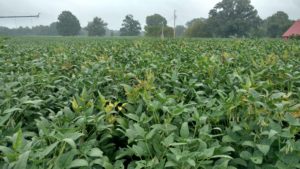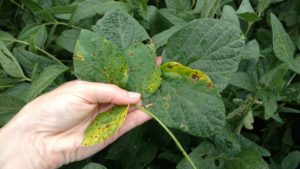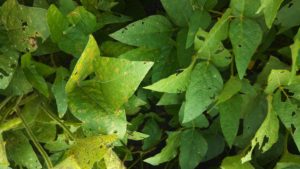In the past weeks soybeans have gotten into reproductive growth stages and diseases have started appearing as well as questions about making fungicides combinations.
As can be expected many diseases of soybean do not appear until reproductive growth stages. Diseases that have been reported in West Tennessee include sudden death syndrome (SDS), target spot, septoria brown spot, and frogeye leaf spot. More resources for disease identification and management options can be found at UTcrops.com and guide.utcrops.com (mobile friendly site).
While interveinal chlorosis (yellowing) and necrosis (dead, brown tissue) are characteristic foliar symptoms of SDS (Image 1) that appear during reproductive growth stages of soybean nothing can be done about the disease at this time in the season. The fungus that causes SDS, Fusarium virguliforme, is in the soil and infects the roots earlier in the season. SDS symptoms and effect on yield can be more severe when soybean cyst nematode (SCN) is also present in the field, because the nematode feeding sites become easy access for the pathogen to enter the plant. So it is important to take soil samples in the fall to check your level of SCN. More information on SCN sampling and where to send samples at utcrops.com/soybean/diseases. The bottom line for SDS – soil borne pathogen, no management options now, but need to sample for SCN, and consider management options for future soybean plantings including variety selection (SDS tolerant and SCN resistant), later planting date, fungicide seed treatment, and/or crop rotation (corn is also a host).
Target spot (Image 2) and septoria brown spot are diseases that usually stay in the lower canopy and depending on variety and weather conditions have very little to no effect on yield. Only if these diseases are getting into the middle canopy during early to mid-reproductive growth stages (R1-R3) might a fungicide application be necessary to protect yield.
Frogeye leaf spot (FLS, Image 3) varies across fields depending on variety, field cropping history, and weather conditions. Most fields planted to a FLS susceptible variety, following soybean, and that have had good moisture will benefit from a fungicide application around beginning pod (R3 – at least one of the top 4 nodes contain a ¼ in. long pod). With strobilurin/QoI resistance in the FLS pathogen population the strobilurin/QoI component in combination fungicides will be ineffective against FLS, although will still protect yield from other diseases. The efficacy of a combination or fungicide mix depends more on the other component(s). General fungicide efficacy table, which lists both the active ingredients, product/trade name, and how well they manage individual diseases (rated poor to excellent) can be found at utcrops.com/soybean/diseases.
While I recommend fungicide combinations that have had the best FLS control and protected yield in my research trials (see Table from previous article on utcrops.com, Scouting for Soybean Diseases and Deciding on Fungicides), making your own fungicide mix with solo-active ingredient fungicides is another option. Again the level of protection will depend on the efficacy of the non-strobilurin/QoI component which is usually a triazole component. Generic triazoles include, Tebuconazole products which are not labeled for FLS (poor efficacy) and Propiconazole products are only fair against FLS. Other triazoles such as those in Topguard, Proline, and Domark are good to very good against FLS. Also the active ingredient of Topsin-M (thiophanate-methyl or ‘t-methyl’) is very good against FLS, but has high risk for fungicide resistance development and it is recommended to use in combination with another component from a different fungicide group (i.e. a triazole component).
As always variety selection is the first and usually strongest line of defense against disease. Find variety information and other disease information on UTcrops.com.




